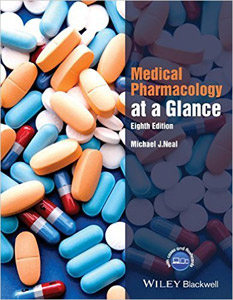내용
Medical Pharmacology at a Glance,8/e
Medical Pharmacology at a Glance is recognised as an excellent starting point for pharmacology study. This
international best-seller is the perfect companion for all medical and health students, providing an accessible, visual
overview of pharmacology.
This 8th edition has been extensively d, especially in the areas of anaesthetics, drugs used in AIDs, cardiovascular
drugs, drugs used in anxiety, depression and schizophrenia, urological drugs, drug metabolism, as well as practical
concerns such as drug indications and side effects.
Ideal for USMLE and pharmacology exam revision, Medical Pharmacology at a Glance features:
• The basic principles of drug action, interaction, absorption and excretion
• Chapters based on diseases or syndrome, for efficient clinical learning
• An emphasis on drug mechanisms
• References to the pathophysiology of disease, to aid understanding of drug choice and action
• Case studies with questions and full explanation of answers
• A companion website at www.ataglanceseries.com/pharmacology featuring online cases and flashcards
Preface vii
Acknowledgements vii
Further reading viii
How to use your textbook ix
About the companion website x
1 Introduction: principles of drug action 2
2 Drug–receptor interactions 4
3 Drug absorption, distribution and excretion 6
4 Drug metabolism 8
5 Local anaesthetics 10
6 Drugs acting at the neuromuscular junction 12
7 Autonomic nervous tem 14
8 Autonomic drugs acting at cholinergic synapses 16
9 Drugs acting on the sympathetic tem 18
10 Ocular pharmacology 20
11 Asthma, hay fever and anaphylaxis 22
12 Drugs acting on the gastrointestinal tract I: peptic ulcer 24
13 Drugs acting on the gastrointestinal tract II: motility and secretions 26
14 Drugs acting on the kidney: diuretics 28
15 Drugs used in hypertension 30
16 Drugs used in angina 32
17 Antiarrhythmic drugs 34
18 Drugs used in heart failure 36
19 Drugs used to affect blood coagulation 38
20 Lipid-lowering drugs 40
21 Agents used in anaemias 42
22 Central transmitter substances 44
23 General anaesthetics 46
24 Anxiolytics and hypnotics 48
25 Antiepileptic drugs 50
26 Drugs used in Parkinson’s disease 52
27 Antipsychotic drugs (neuroleptics) 54
28 Drugs used in affective disorders: antidepressants 56
29 Opioid analgesic 58
30 Drugs used in nausea and vertigo (antiemetics) 60
31 Drug misuse and depence 62
32 Non-steroidal anti-inflammatory drugs (NSAIDs) 64
33 Corticosteroids 66
34 Sex hormones and drugs 68
35 Thyroid and antithyroid drugs 70
36 Antidiabetic agents 72
37 Antibacterial drugs that inhibit nucleic acid synthesis: sulphonamides, trimethoprim, quinolones and nitroimidazoles
74
38 Antibacterial drugs that inhibit cell wall synthesis: penicillins, cephalosporins and vancomycin 76
39 Antibacterial drugs that inhibit protein synthesis: aminoglycosides, tetracyclines, macrolides and chloramphenicol 78
40 Antifungal drugs 80
41 Antiviral drugs 82
42 Drugs acting on parasites I: helminths (worms) 84
43 Drugs acting on parasites II: protozoa 86
44 Drugs used in cancer 88
45 Immunosuppressants and antirheumatoid drugs 90
46 Poisoning 92
47 Adverse drug reactions 94
Case studies and questions 96
Answers 98
Index 102


